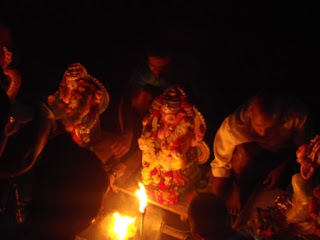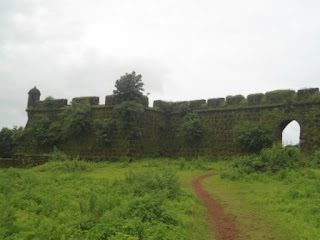I had to head into the small city of Mapsa to get an issue with my Internet connection sorted out. It’s about 45 minutes on the scooter and I thought I’d take advantage of having rented a bike so I decided to head to Anjuna beach for lunch. I have been to Anjuna 3-4 times before and wrote about the market they have there during the tourist season. In case you missed it, Anjuna used to sport the reputation of being the “freak capital of the world” in the 90s with lots of recreational drugs, many trance parties and people trying to combine the spiritual traditions of the east with the west’s hippie art and music.
Looking down at Anjuna beach:

Today however, it was a very quiet beach with the sun shining down on the relatively calm sea. I explored some of the back roads on the scooter before stopping at the south end of the beach. There’s a small knoll defining the border of the beach and I’ve seen guys paragliding there before but not close up. Today a man was just setting up so I watched him take off and fly around for a bit. It looked nice but it is a pretty small hill, smaller than Arambol.
The solo paraglider in flight:

As I walked along the beach, looking for a restaurant for lunch, I passed three young women picking up sticks and placing them into their white canvas bags. I figured that they were just gathering firewood for cooking at home. The youngest of the three said hi to me as I walked by which I reciprocated with a “Namaste”. She then proceeded with the common “Where are you from?” question. We chatted for a few minutes and I learned that she was 13 years old and her name was Anita. Her friends were 16 year old Lalita and 17 year old Sunnita...no wonder they’re friends!
As I began to wander off continuing my search for a lunch spot, Anita called out and started to walk towards me. She asked whether I would buy a drink for them as they were working hard in the hot sun and were parched. There was something about her style and technique and even her boldness that I had to admire and for a small amount of money (to me), why not help these young women out? There wasn’t an obvious place to buy refreshments right there so instead I offered her 100 rupees (a little over $2) for her to buy some soft drinks and she’d even have a little change left over.
My three new friends:

Seeing that I was in a good mood, Anita upped her ante and asked whether I could buy some chicken noodles that they could share. They weren’t actually collecting the sticks for their homes but would be taking them to Mapsa to sell for a minimal amount of money considering the effort. Okay, how could I refuse? Anita, the sly girl, then raised the stakes again and requested 3 chicken noodles. I think it was the fact that she was looking out for her friends that I caved on that request too.
The restaurant was just around to corner and sadly they aren’t allowed to go there. So I told them I would return within the hour with their food and drinks. I sat at a table by the sea and ordered a sandwich along with the three chicken noodles (to go) and three Cokes. I ate my sandwich and then headed back down the beach to find the three girls sitting patiently with big smiles on their faces.
We sat together in the sand as they opened up the containers. I was asked a couple of times by Anita and Lalita if I wanted some noodles but I declined. Regardless, Anita scooped some noodles onto one of the lids of the containers and passed it to me. “It is better if we all eat together” she said. I thought that was pretty cool and wise for a 13 year old. She has a good head on her shoulders but sadly she’s no longer in school as her family can’t afford it.
Me with Lalita on the left and Sunnita on the right:

Anita take a self shot:

Anita snapped one of me:

We chatted about a variety of topics and I thoroughly enjoyed their company. As they finished their food, Anita warned me of some lamanis (beach sellers of jewellery, sarongs etc.) approaching. I was the only “gorah” (foreigner) on the beach, so the only target. It didn’t really matter to me, I had but 30 rupees left in my wallet and buying jewellery and sarongs is pretty low on my to do list. The girls were off to catch a bus into Mapsa to sell their wood while I hopped back on my scooter to head back to Arambol.
The "Itas":

Thanks for a pleasant afternoon Anita, Lalita & Sunnita!
























